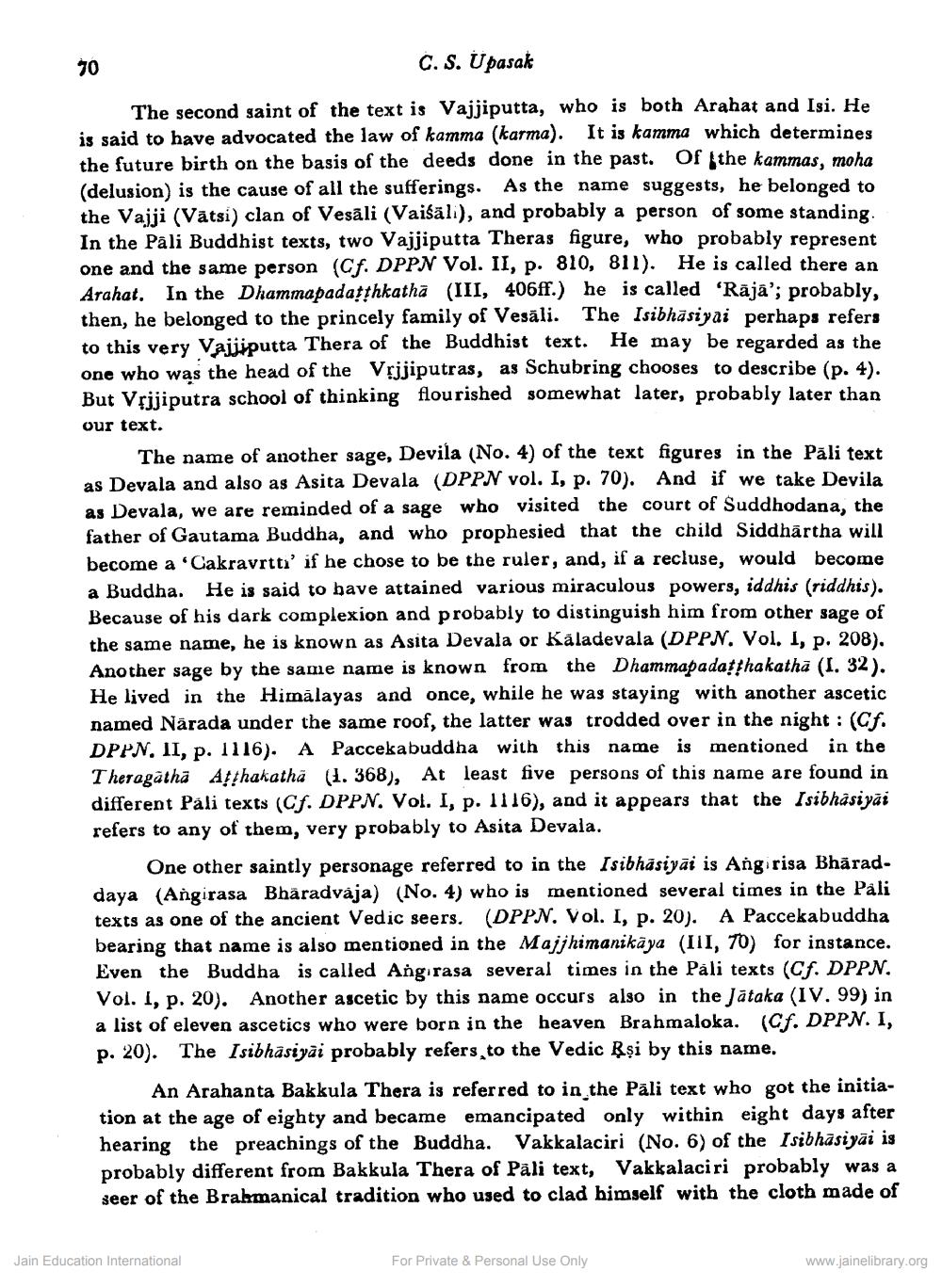Book Title: Isibhasiyai and Pali Buddhist Texts A Study Author(s): C S Upasak Publisher: Z_Aspect_of_Jainology_Part_3_Pundit_Dalsukh_Malvaniya_012017.pdf View full book textPage 3
________________ C. S. U pasak The second saint of the text is Vajjiputta, who is both Arahat and Isi. He is said to have advocated the law of kamma (karma). It is kamma which determines the future birth on the basis of the deeds done in the past. Of the kammas, moha (delusion) is the cause of all the sufferings. As the name suggests, he belonged to the Vajji (Vātsi) clan of Vesāli (Vaiśäli), and probably a person of some standing. In the Pali Buddhist texts, two Vajjiputta Theras figure, who probably represent one and the same person (Cf. DPPN Vol. II, p. 810, 811). He is called there an Arahat. In the Dhammapadatthkathā (III, 406ff.) he is called "Rājā'; probably, then, he belonged to the princely family of Vesāli. The Isibhasiyai perhaps refers to this very Vajjiputta Thera of the Buddhist text. He may be regarded as the one who was the head of the Vrjjiputras, as Schubring chooses to describe (p. 4). But Vrijiputra school of thinking flourished somewhat later, probably later than our text. The name of another sage, Devila (No. 4) of the text figures in the Pali text as Devala and also as Asita Devala (DPPN vol. I, p. 70). And if we take Devila as Devala, we are reminded of a sage who visited the court of Suddhodana, the father of Gautama Buddha, and who prophesied that the child Siddhartha will become a 'Cakravrtti' if he chose to be the ruler, and, if a recluse, would become a Buddha. He is said to have attained various miraculous powers, iddhis (riddhis). Because of his dark complexion and probably to distinguish him from other sage of the same name, he is known as Asita Devala or Kaladevala (DPPN. Vol. I, p. 208). Another sage by the same name is known from the Dhammapadatthakatha (I. 32). He lived in the Himalayas and once, while he was staying with another ascetic named Närada under the same roof, the latter was trodded over in the night: (Cf. DPPN. II, p. 1116). A Paccekabuddha with this name is mentioned in the Theragathā Afthakatha (1. 368), At least five persons of this name are found in different Páli texts (Cf. DPPN. Vol. I, p. 1116), and it appears that the Isibhásiyāi refers to any of them, very probably to Asita Devala. One other saintly personage referred to in the Isibhāsiyāi is Ang risa Bhāraddaya (Angirasa Bhäradvája) (No. 4) who is mentioned several times in the Pali texts as one of the ancient Vedic seers. (DPPN. Vol. I, p. 20). A Paccekabuddha bearing that name is also mentioned in the Majjhimanikāya (III, 70) for instance. Even the Buddha is called Ang rasa several times in the Pali texts (Cf. DPPN. Vol. I, p. 20). Another ascetic by this name occurs also in the Jataka (IV. 99) in a list of eleven ascetics who were born in the heaven Brahmaloka. (Cf. DPPN. I, p. 20). The Isibhâsiyai probably refers to the Vedic Rşi by this name. An Arahanta Bakkula Thera is referred to in the Pāli text who got the initiation at the age of eighty and became emancipated only within eight days after hearing the preachings of the Buddha. Vakkalaciri (No. 6) of the Isibhāsiyāi is probably different from Bakkula Thera of Pāli text, Vakkalaciri probably was a seer of the Brahmanical tradition who used to clad himself with the cloth made of Jain Education International For Private & Personal Use Only www.jainelibrary.orgPage Navigation
1 2 3 4 5 6
